
Nottinghamshire is a ceremonial county in the East Midlands of England. The county borders South Yorkshire to the north-west, Lincolnshire to the east, Leicestershire to the south, and Derbyshire to the west. The largest settlement is the city of Nottingham (323,632).

Pleasley is a village and civil parish with parts in both Derbyshire and Nottinghamshire. It lies between Chesterfield and Mansfield, 5 miles (8 km) south east of Bolsover, Derbyshire, England and 2.5 miles (4 km) north west of Mansfield, Nottinghamshire. The River Meden, which forms the county boundary in this area, runs through the village.

Eastwood is a former coal mining town and civil parish in the Broxtowe district of Nottinghamshire, England, 8 miles (13 km) northwest of Nottingham and 10 miles (16 km) northeast of Derby on the border between Nottinghamshire and Derbyshire. Mentioned in Domesday Book, it expanded rapidly during the Industrial Revolution. The Midland Railway was formed here and it is the birthplace of D. H. Lawrence.

Ollerton is a town and former civil parish, now in the parish of Ollerton and Boughton, in the Newark and Sherwood district, in the county of Nottinghamshire, England, on the edge of Sherwood Forest in the area known as the Dukeries. The population of Ollerton and Boughton at the 2011 census was 9,840.
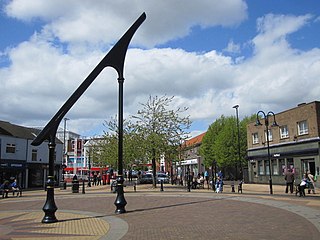
Ashfield is a local government district in Nottinghamshire, England. The council is based in Kirkby-in-Ashfield, but the largest town is neighbouring Sutton-in-Ashfield. The district also contains the town of Hucknall and a few villages. The district is mostly urban, with some of its settlements forming parts of both the Nottingham and Mansfield Urban Areas.

Hucknall, formerly Hucknall Torkard, is a market town in the Ashfield district of Nottinghamshire, England. It lies 7 miles (11 km) north of Nottingham, 7 miles (11 km) southeast of Kirkby-in-Ashfield, 9 miles (14 km) from Mansfield and 10 miles (16 km)south of Sutton-in-Ashfield. It is the second-largest town in the Ashfield district after Sutton-in-Ashfield.

Sutton-in-Ashfield is a market town in Nottinghamshire, England, with a population of 48,527 in 2019. It is the largest town in the district of Ashfield, four miles west of Mansfield, 2 miles (3 km) from the Derbyshire border and 12 miles (19 km) north of Nottingham.

Blidworth is a village and civil parish approximately five miles east of Mansfield, Nottinghamshire, England. The population of the civil parish at the 2011 census was 4,457, this dropped to 4,295 in the 2021 census. Its history can be traced back to the 10th century, although many of the current houses were built in the first half of the 20th century to provide housing for workers at Blidworth Colliery (1926–1989). These are mainly in estates north of Dale Lane, known as New Blidworth. The area around Main Street, west of Beck Lane and including the church, is Old Blidworth, containing some of the oldest buildings. Blidworth Bottoms is a hamlet about 0.5 km south of Old Blidworth, while Haywood Oaks is the portion of the village south of Dale Lane and the south eastern rural area of the parish surrounding Haywood Oaks Lane.
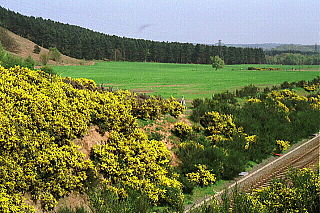
Annesley is a village and civil parish in the Ashfield district of Nottinghamshire, England, between Hucknall and Kirkby-in-Ashfield. At the 2011 census, it had a population of 1,162, and this increased to 1,814 at the 2021 census.

Clipstone is a former mining village in the Newark and Sherwood district of Nottinghamshire, England. The population of the civil parish was 3,469 at the 2001 census, increasing to 4,665 at the 2011 census, and substantially more so to 6,185 at the 2021 census.
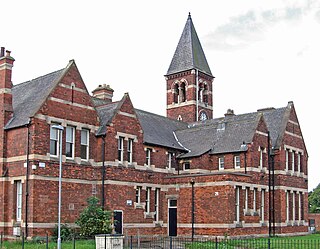
Bestwood Village is an village and civil parish in the Gedling district of Nottinghamshire.
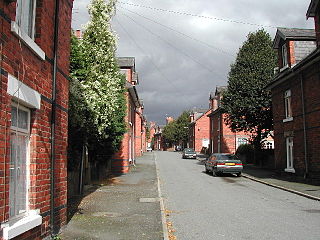
Hilcote is a small village in the south of the Bolsover district in Derbyshire, England, located close to the A38 junction with the M1.

Viyella is a blend of wool and cotton first woven in 1893 in England, and the "first branded fabric in the world". It was made of 55% merino wool and 45% cotton in a twill weave, developed by James and Robert Sissons of William Hollins & Co, spinners and hosiers. The brand name, first registered as a trademark in 1894, and registered in the United States in 1907, soon covered not only the original fabric, to be sold by the yard, but also clothing. At first this was made by separate businesses, but it was not long before Hollins started producing their own clothes and offering franchises to manufacturers who would use the Viyella label. Following increasing emphasis on garment manufacture over the years, Viyella is now a fashion brand for clothes and home furnishings made of a variety of fabrics. The original wool/cotton blend is no longer sold.
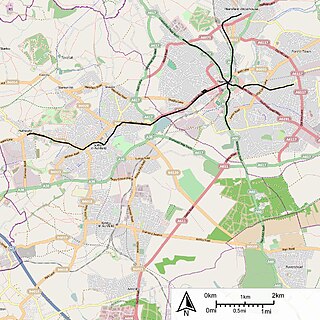
Mansfield & District Light Railways was an electric tramway network operating in Mansfield from 16 July 1905 to 9 October 1932. The tramway company was a subsidiary of Midland Counties Electric Supply Company, who in turn were owned by Balfour Beatty.
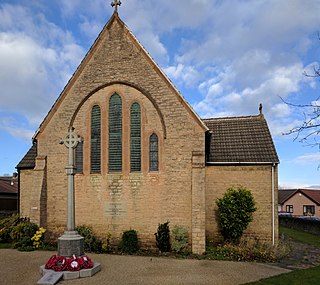
Stanton Hill is a village in the Ashfield district of Nottinghamshire.

Silverhill is an artificial hill near Teversal in Nottinghamshire, and is one of the highest points in the county at 204.3 metres (670 ft). Originally it was a mine spoil heap on the site of the former Silverhill colliery which closed in the 1990s. It was subsequently landscaped in 2005 by Nottinghamshire County Council, with tree planting, numerous footpaths, and a viewpoint. It is now known as Silverhill Woods, and is one of a number of recreation sites in the area. These are linked together by multi-user trails, many of which incorporate the track beds of disused railway lines which once served the various local collieries.
Arthur Betts was a professional Association Footballer who played for Nottingham Forest.

Louis Ambler FSA FRIBA was an English architect.
The Leen Valley lines of the Great Northern Railway were railway branch lines built to access the collieries in the Nottinghamshire coalfield in England. The Midland Railway had long been dominant in the area, but there was resentment against its monopolistic policies from coalowners, who encouraged the Great Northern Railway to build a line. The Leen Valley Line was opened in 1881; it ran as far as Annesley colliery. A passenger service was run the following year, and very considerable volumes of coal were hauled.





















